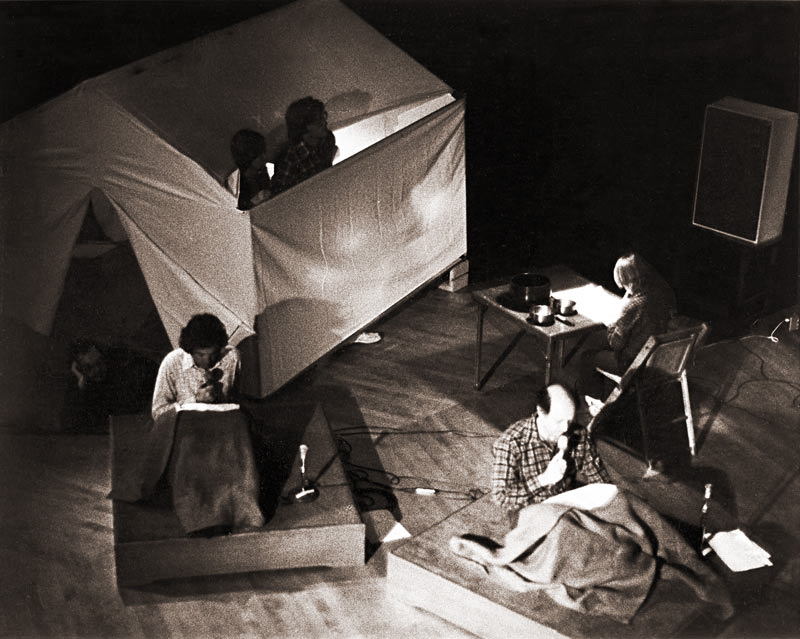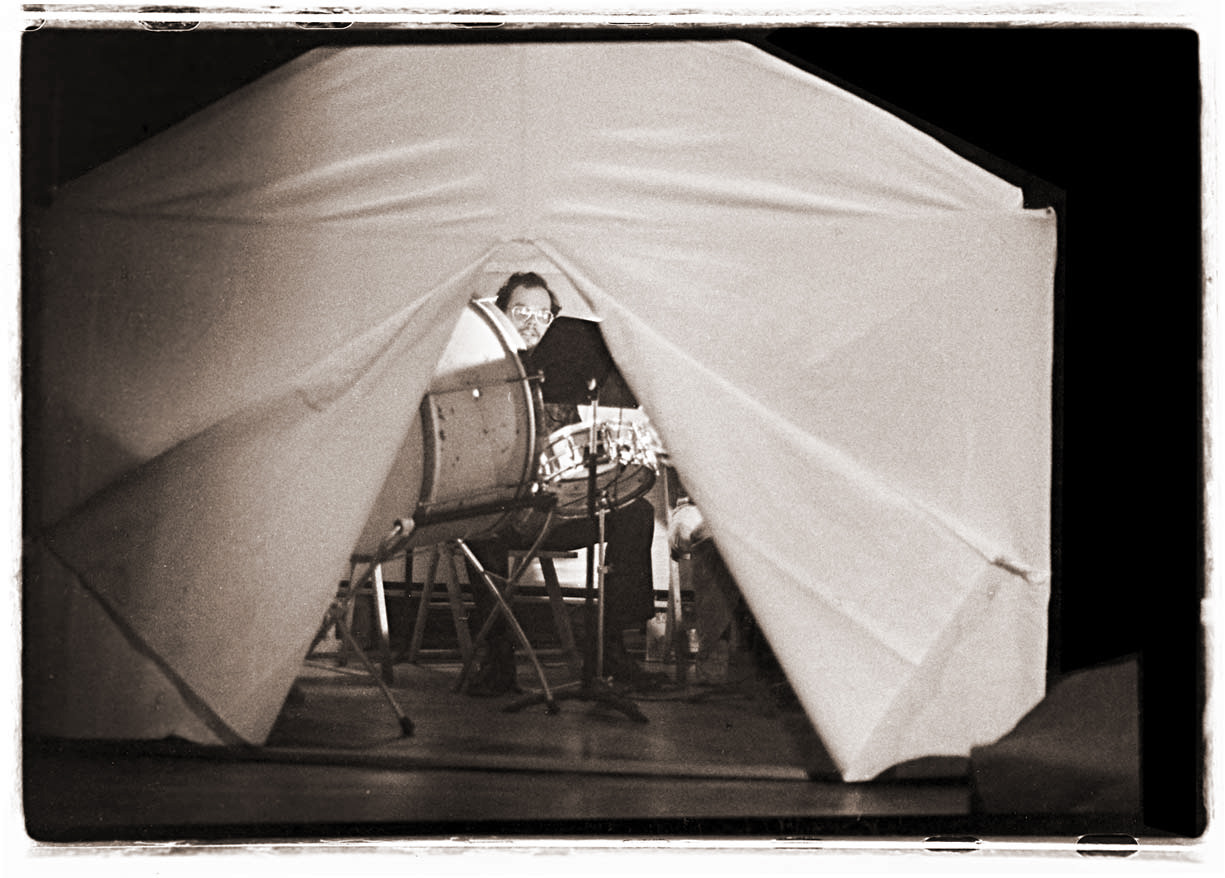Egusquiza to Falsetto

Photo © 1979 Marion Gray. More photos...
Synopsis
Co-created by Charles Amirkhanian and Margaret Fisher for the Arch Ensemble for Experimental Music based in Berkeley, CA, Egusquiza to Falsetto takes its name from the spine of an encyclopedia volume. The music score is for nine instrumentalists, vocal quartet, water cooler, and an electronic tape made from sounds of the Pacific Ocean at Aptos, California, and a stream wending its way through the regional Parks Botanic garden in Tilden Park, Berkeley.
The essence of the work lies in the unassuming intimacy developed among the players. Musicians are encamped on two levels to give the uncontained sense of an outdoor scene without the use of a backdrop or other props. The percussionists are housed within a white tent on the second level. A ten year old boy writing at a desk is seen on the second level. Instrumentalists lie on their sides under blankets, their knees folded into their chests. The oboist lies atop the violist, each on their side, as though the vertical side-stacking of bodies were an ordinary sleeping arrangement. The bassoon hangs horizontally above the head of the bassoonist. A male vocal quartet recites text sound poetry. At one point the somnolent mood is broken by loud percussive intrusions that cause the tent to billow and flap. The cellist mouths the silent scream of a bad dream, curls up and appears to sleep once more. The boy at the desk leaves his chair and softly strikes three Buddhist temple bowls with a small mallet.
Several of the members of the Arch Ensemble had been members of the Ghost Opera, a San Francisco improvisational company which used theater games to provide sensitive guidelines for impromptu playing. Margaret Fisher, a practitioner in new dance media, worked the scale of the human figure at odds with the scale of her environmental constructions to bring human gesture into high relief. Her movement choices often resulted in musical choices, and vice versa. Charles Amirkhanian’s music is the third of a series of pieces for chamber orchestra. This work extended his interest in mixing sound poetry texts with the recordings of ambient sounds. More details about the work are found in the reviews below.
Credits
- Composer: Charles Amirkhanian
- Choreographer/Design: Margaret Fisher
- Performing Forces: large ensemble, one each instrument
- Performing Ensemble: Arch Ensemble for Experimental Music
- Duration: c. 12 minutes
Performance History
- Premiere: The Arch Ensemble, Mills College Concert Hall, Oakland, CA, May 4, 1979
- Performance: The Arch Ensemble, Red Branch Hall, San Francisco, CA, May 5, 1979
- Performance: The Arch Ensemble, Cabrillo College Theater, Cabrillo Music Festival, August 23, 1980
Reviews
- “Performance, Arch Ensemble,” Paul Nash, City Celebration, San Francisco. May, 1979. “The Arch Ensemble is one of a precious handful of new music groups devoted almost entirely to the showcasing of the works of Bay Area composers. Now in its third season under the direction of conductor-composer Robert Hughes, the ensemble presented its second program this year at a previously untried space south of Market called Redwood Hall.
“The Amirkhanian-Fisher work, whimsically entitled Egusquiza Falsetto (after an alphabetically designated encyclopedia volume) was an assemblage of staging, minimal movement, taped sound, and instrumental sounds all intended as 'references to an indoor-outdoor scene'.
“The most delightful moment of this work (the first on the program) for this writer was the way it set the tone of the concert. Even as people are still filtering into the hall, the players (most with instruments) appear on stage one at a time, all plaid shirted and carrying red blankets, and promptly curl up to sleep.
“A boy sits down at a desk and begins to write (about a dream, I imagine). This he continues for the duration of the work. The sounds of marching feet, then running water fill our ears. the players closest to the audience, including Amirkhanian and Hughes, awaken first to play jaw harps; and then recite a series of word images in unison and imitative fashion. This procedure and style of sound-poetry called text sound relates words not through syntax or association, but more through their phoneme and syllable content. Only by hearing the full nexus of words can we begin to extract the image or situation from which the choices of words might in part spring.
“In a dramatic and intentionally rude moment the audience and players alike are shaken from their dreaming state by the raucousness of car horns and marching drums. Unable to sleep, the instrumentalists begin to play while still lying on their backs, thumping out a series of random sounding chords while three others sound a simple but distantly related melody in unison.
“This writer found all these goings-on quite entertaining and humorous, and hopes he was not left out on other intentions.” - “The Arch Flaws of the Arch Ensemble,” Marilyn Tucker, San Francisco Chronicle, May 7, 1979. “When grown men and women try to play musical instruments while covered with blankets and lying on the floor, you either know that someone is trying to pull your leg or bring back the glories of conceptual art.
- “Entrancing performance by the Arch Ensemble,” Charles Shere, The Tribune, May 8, 1979. “The Arch Ensemble has proved in its two years that ‘new music’ is evolving here in a healthy direction.... No longer committed to abstruse musical values meaningful only to initiates, it offers entertainment, thoughtfulness and beauty to audiences from the visual arts and from pop cultures as well as to musicians.
“Friday night at Mills College, John Adams led the Arch group in a generous program including a premiere commissioned by them. A collaboration between sound-text poet-composer Charles Amirkhanian and dancer-stage designer Margaret fisher, ‘Egusquiza to Falsetto’ was visually extremely handsome.
“It began the concert on a note of austere, mysterious but reassuringly familiar beauty. The musicians lay next to their instruments on a darkened stage, each with a red blanket tossed over them. Above the stage, in the open organ loft, was a table looking like a desk and an old-fashioned white cabin tent.
“Gradually half the band alternated a rhythmic repeated chord with a simple melodic line; the other half began chanting concrete poetry—‘cinema chime crime, cinema chime’ and so on...
“‘Egusquiza’ broke off too soon. Its arbitrarily encyclopedic, unlinear visual and musical logic could contain more.”
